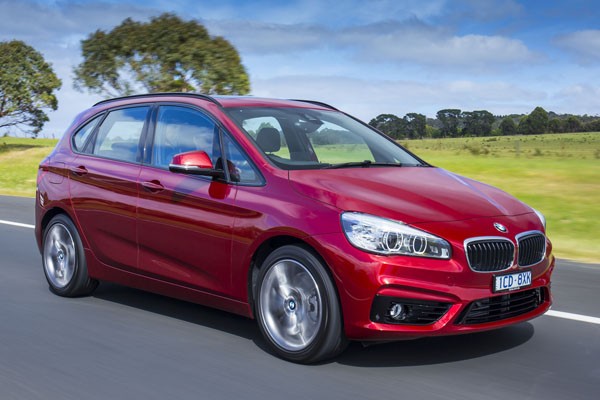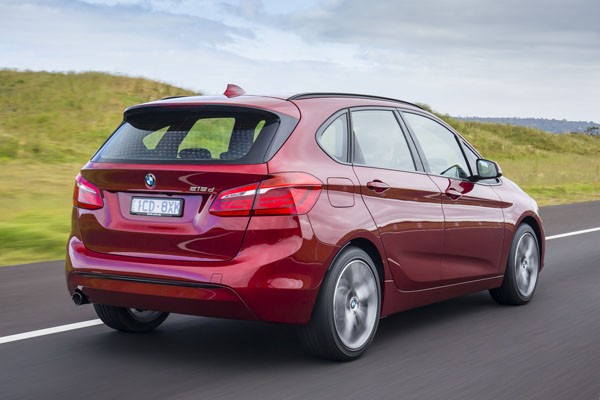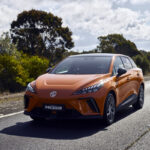It had to happen. BMW traditionally has carried the banner for rear-wheel drive vehicles for decades, building success on the philosophy that the set-up delivers maximum satisfaction to the driver.
Now, with its centenary coming up in 2016, in a quest for more room for passengers, the German automobile giant has launched its first front-wheel drive model – the 2 Series Active Tourer.
At 4342 mm long, the long 2670 mm wheelbase and 1555 mm tall body, slightly bigger than the BMW X1, with seating for five and versatile cargo carrying capacity, the car puts a new slant on the premium compact segment.
The rear seatback, for example, can be split 40/20/40, while the 60/40 split rear seat itself leaves room for up to 1510 litres of luggage, with loading made easy thanks to a low lip together with an automatic opening and closing tailgate. Add to this the choice of four variants priced from $44,400, the 2 Series Active Tourer brings more than a fresh face to the market.
With four models in the line-up, and the choice of three petrol and one diesel BMW TwinPower turbocharged engines, designations are 218i Active Tourer, 218d Active Tourer, 220i Active Tourer and 225i Active Tourer. All but the 220i Active Tourer are on sale now, the 220i landing here in the new year.
The entry-level 218i, Active Tourer is a revelation with its three-cylinder 1.5-litre turbo motor. This engine is a first for BMW, though it has been used in the Mini for a while (these days Mini is owned by BMW). The triple is mated with a six-speed Steptronic automatic transmission and delivers 100 kW of power and 220 Nm torque to the front wheels. The engine has the characteristic three-pot accompaniment as discovered on an extensive launch drive in Tasmania.
BMW says the combined urban / highway fuel consumption can be as low as 5.2 litres per 100 kilometres, with carbon dioxide emissions of 122 grams per kilometre. The 218d, with its 110 kW / 330 Nm 2.0-litre four-cylinder diesel and eight-speed Steptronic automatic transmission, does even better, with 4.2 litres per 100 kilometres and 111 grams per kilometre.
For those who want to have a crack at the maker’s zero-to-one-hundred-kilometre sprint time of 6.2 seconds and on to a top speed of 240 km/h, where allowed, the 225i Active Tourer is just the job. Its 170 kW of peak power and 350 Nm of top torque from the 2.0-litre four-cylinder turbo-petrol engine are put to ground through an eight-speed Steptronic Sport automatic transmission.
Both six and eight-speed Steptronics come standard with dial-up Comfort, Eco Pro and Sport modes which can match the driver’s mood, with vehicle performance ranging from reined-in fuel economy to under-the-whip get-up-and-go.
All four powertrain options make use of BMW’s EfficientDynamics technology including automatic engine stop-start and brake energy regeneration.
Standard specifications across the range are extensive and, like BMW does, there are enough cost options to buy a small Korean car. All models feature power tailgate, climate control, auto lights and wipers, park distance control, satellite navigation, Bluetooth, six airbags, Dynamic Stability Control and Traction Control.
There’s also a clutch of BMW ConnectedDrive safety and driver aids. The latter consists of Parking Assistant, rear-view camera, Driving Assistant with lane departure warning, Intelligent Emergency Call automatically connecting with emergency services in the event of a crash and transmission of vehicle service data to a central control.
Putting performance to the side, the 2 Series Active Tourer earns its value-for-money stripes with many ways to keep occupants comfortable and entertained. Sound plays through a standard six-speaker sound system with USB and Aux inputs.
Added to these are satellite navigation, extended Bluetooth functions with voice control, audio streaming and pairing of multiple devices. All essential detail is displayed on a 6.5-inch screen on the central dashboard with functions controlled by the iDrive knob close at hand on the centre console.
The halo 225i Active Tourer also benefits from Dakota leather seats, LED headlights, exterior mirrors with automatic park and folding functions, plus an LED ambient light package.
The switch from rear to front drive is on show from the start, with understeer taking over where oversteer left off. Not that there’s much of either to put off drivers of most modern cars – it takes a lot of rough treatment to unsettle the 2 Series Active Tourer.
Dial-up driving modes alter the car’s behaviour considerably, from wheezing fuel economy to lung bursting high performance.
There’s much to satisfy the followers of the command driving position. However, the super-size A-pillars, despite incorporating quarter lights, create substantial blind spots.
The car’s road hugging stance is not only for show, with the 17 or 18-inch light alloy modern design wheels shod with 205/55 or 245/55 tyres keeping in firm contact with the bitumen.
On the move, a couple of gripes include excessive tyre noise on some road surfaces and the wind’s low whistle around A-pillars and exterior mirrors at cruising speeds.
A range of servicing packages is available for the 2 Series Active Tourer. Starting at $990, BMW Service Inclusive looks after scheduled servicing for five years or 80,000 kilometres, whichever comes first.
AT A GLANCE
BMW 218i Active Tourer: $44,400
BMW 218d Active Tourer: $47,800
BMW 220i Active Tourer: $50,900
BMW 225i Active Tourer: $54,900
Note: These prices do not include dealer or government charges. Contact your local BMW dealer for drive-away prices.













